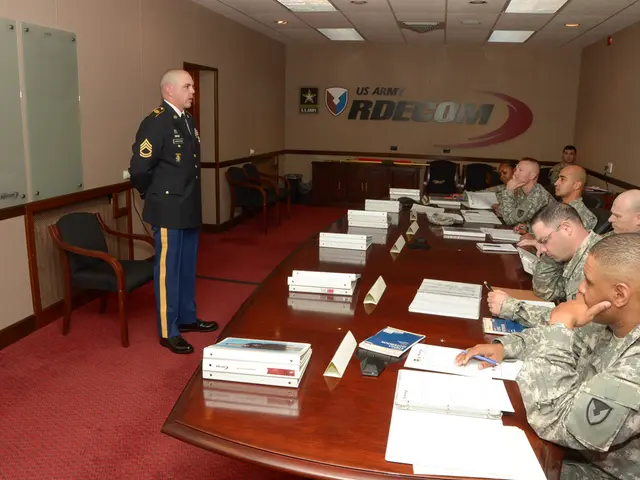Research Center for Space Exploration and Technology Focusing on the Search for Extraterrestrial Intelligence
In the vast expanse of the universe, the question of whether we are alone persists. To answer this question, the Search for Extraterrestrial Intelligence (SETI) has become a significant focus for scientists, researchers, and organisations worldwide. One such organisation is the SETI Institute, a non-profit research centre based in Mountain View, California.
Founded in 1984 by Thomas Pierson, the SETI Institute is dedicated to finding evidence of extraterrestrial life. The Institute's work revolves around the concept of technosignatures, any detectable evidence of advanced technology from extraterrestrial civilizations. These technosignatures can take the form of observable aspects or signs of advanced technology produced by intelligent extraterrestrial life, including electromagnetic emissions, megastructures, or artifacts.
Dr. Jill Tarter, former director of the Centre for SETI Research at the SETI Institute, believes that the search for extraterrestrial life is also a search for clues about the nature and origin of life in the universe. Advanced sentience, a highly evolved, intelligent, and self-aware being or entity beyond what is currently understood or observed in known life forms, is a concept often discussed in this context.
The SETI Institute collaborates with scientists and researchers from all over the world in this quest. They use cutting-edge technology and innovative techniques to search for extraterrestrial signals. One such method is the technosignature search, where SETI researchers focus on detecting technosignatures by analysing radio signals and other data from space. They leverage extensive logs from NASA’s Deep Space Network to understand Earth’s own strong radio transmissions and improve strategies for detecting alien signals elsewhere in the galaxy.
Recognising the challenge posed by satellite constellations like SpaceX’s Starlink, SETI is collaborating directly with SpaceX to mitigate interference affecting sensitive radio astronomy observations. This partnership aims to develop responsible engineering standards for satellite emissions to protect cosmic radio frequencies crucial to searches for extraterrestrial signals.
The Institute is also advancing the search for extraterrestrial life through AI and machine learning (ML) analysis of exoplanet data. Dr. Isabel Angelo, the recipient of the Davie Postdoctoral Fellowship, is developing advanced AI/ML techniques to sift through massive datasets from telescopes like Kepler and Gaia. Her work enhances convolutional neural networks and anomaly detection methods to uncover subtle or unconventional exoplanets, complex planetary systems, exocomets, and possibly alien megastructures.
In addition to its research efforts, the SETI Institute has an active education and outreach program. It seeks to engage the public in the search for extraterrestrial life and foster a deeper understanding of the universe. The Institute is funded by a combination of government grants, private donations, and corporate sponsorships.
Despite the lack of concrete evidence of extraterrestrial life so far, the failure to find any may be due to our limited understanding of the universe and the possible forms that extraterrestrial life may take, according to astrophysicist Paul Davies. The search continues, and with advancements in AI, machine learning, and technologically informed observation strategies, the future of SETI looks promising.
[1] Berger, J. (2020). SETI's search for extraterrestrial intelligence is getting a boost from machine learning. MIT Technology Review. Retrieved from https://www.technologyreview.com/2020/01/15/100347/setis-search-for-extraterrestrial-intelligence-is-getting-a-boost-from-machine-learning/
[2] SETI Institute. (n.d.). SETI Institute and SpaceX partner to protect radio astronomy. SETI Institute. Retrieved from https://www.seti.org/news/seti-institute-and-spacex-partner-protect-radio-astronomy
[3] SETI Institute. (n.d.). Davie Postdoctoral Fellowship. SETI Institute. Retrieved from https://www.seti.org/research/davie-postdoctoral-fellowship
[4] SETI Institute. (n.d.). NASA collaborations. SETI Institute. Retrieved from https://www.seti.org/research/nasa-collaborations
[5] SETI Institute. (n.d.). SETI Institute's technological innovations. SETI Institute. Retrieved from https://www.seti.org/research/seti-institute%E2%80%99s-technological-innovations
- The SETI Institute, a worldwide renowned research center, worked on detecting technosignatures, which are any observable indications of advanced technology from alien civilizations, such as electromagnetic emissions, megastructures, or artifacts.
- Dr. Isabel Angelo, a recipient of the Davie Postdoctoral Fellowship at the SETI Institute, is leveraging advancements in AI and machine learning to analyze exoplanet data, aiming to uncover subtle exoplanets, complex planetary systems, and even potential alien megastructures.
- Collaborating directly with Elon Musk's SpaceX, the SETI Institute is developing responsible engineering standards for satellite emissions to protect cosmic radio frequencies vital to searches for extraterrestrial signals, considering the interference posed by satellite constellations like SpaceX’s Starlink.




